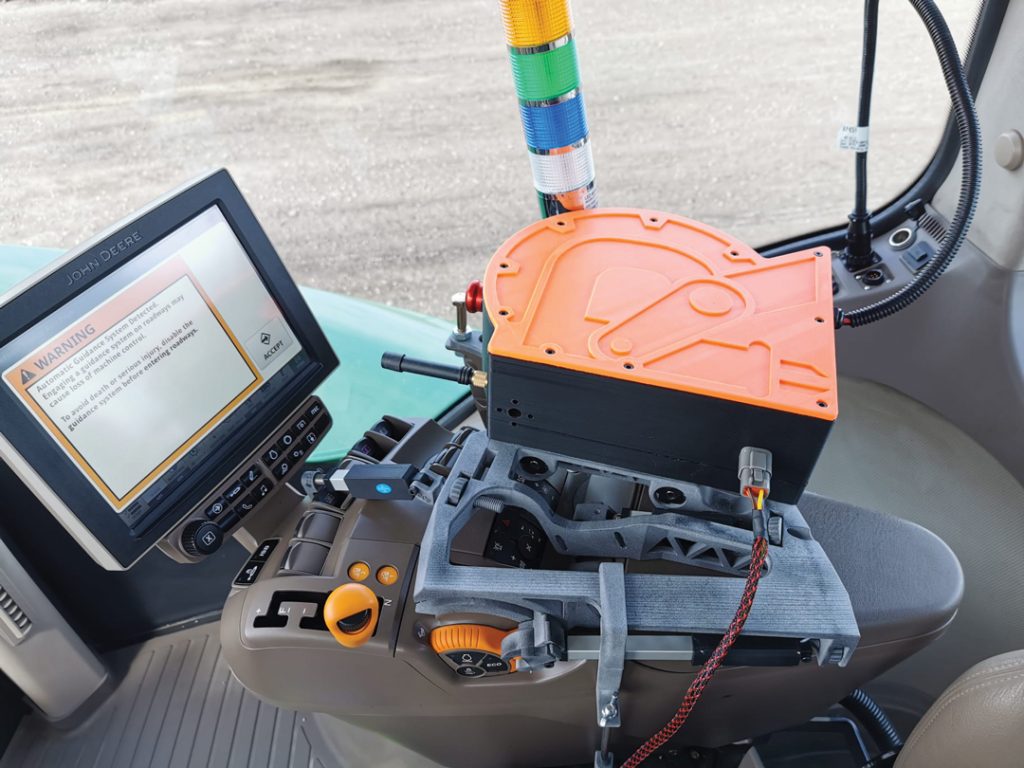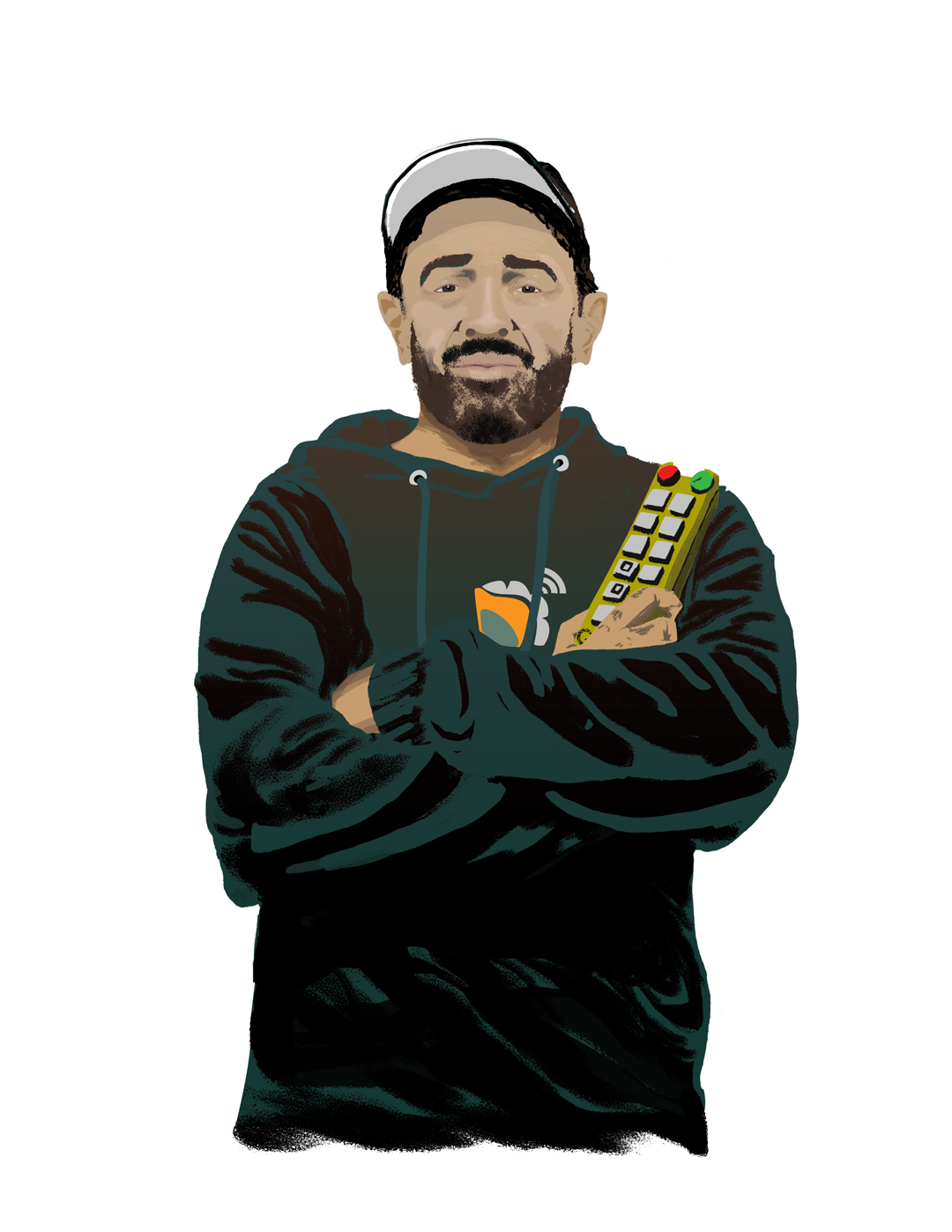REMOTE POSSIBILITIES
BY ELLEN COTTEE • ILLUSTRATION BY CHELSEA BOOS
Raised on a farm in Peace Country, Vincent Pawluski has always loved to tinker. As a kid, he hot-rodded a Fischer Price boat with a small motor and propellor. Later, as part of an elementary school science fair project, he and his friends created a remote-controlled drill stem like those used in the oil and gas industry.
He continued to invent remote control devices as an adult, but never dreamed one of them might become a hit with fellow farmers. Created as a spare time project, Pawluski’s RcFarmArm won a Canada’s Farm Show award and Agri-Trade’s Ag Innovation Award in 2021, as well as the Manitoba Ag Days Innovation Showcase award in the Farm Built Solution category in 2022. He has now launched an on-farm business to produce the patent-pending wireless tractor power-takeoff (PTO) control system.
The RcFarmArm can be installed over a tractor’s arm rest and ignition key. With no hard-wiring required, it works like a driver’s arm and hand to turn the ignition key, control the PTO and operate hydraulics. It can start, stop and control the engine as well as augers, baggers and other stationary equipment.
GrainsWest: You grew up on a farm, but you left for a time. What brought you back?
Vincent Pawluski: I had a large farm that was just too much for my father and I, so I decided to do something else. We sold the farm and I took a sabbatical. My kids, my wife and I travelled the United States in a motorhome. Then we moved to Okotoks where I ended up working in construction before getting an ag job with Seed Hawk. That pointed me back towards farming. We moved back up to Peace Country to start farming again.
Farming is like a disease in the sense that there’s truly no cure for it. Even when we were travelling, we always felt most comfortable near some type of ag activity. I needed that in my life to give me balance and purpose.
GW: What drives you to tinker and invent?
VP: It’s the challenge of controlling pieces of equipment. Remote control vehicles were always a big thing for me, and that’s where it stems from. If you can make that little car move like that, maybe you can make it do something else.
GW: What is unique about the RcFarmArm?
VP: It’s made to sit on top of the armrest and ignition. there’s no wiring, and there’s no alteration of the tractor at all. You put it on with two screws, that’s it. When you take it off, you don’t know it was ever on there. Usually, autonomous tech requires cutting wires or drilling holes to make it work.
GW: At its base, the RcFarmArm is a set of mechanical “fingers” that push, pull and turn various controls from outside the tractor cab. How does a simple remote run all of that?
VP: Using the remote, you press the “on” button to put the tractor key into position and then use a combination of buttons to turn the key—two buttons at once, as a control. There are lights for each function: PTO, RPM and two hydraulic controls, plus four other buttons on every model for a user to control other equipment. You can then hit stop on the remote and it brings everything back to its home position—the off position.
It’s best used for stationary work, like dealing with grain bags and extractors, although the tractor is still drivable with the RcFarmArm on it.
GW: How has the design of the RcFarmArm evolved from your first prototype?
VP: We’ve had a lot of growth and change to our product as we’ve gone along. We keep redesigning to make it better. Our original starter system was just two little actuators that moved the key 45 degrees, but we found that in some tractors, ignition switches need 50 degrees to shut the tractor off. Customers were having a hard time getting it set so that it would do all three functions of the key, so we came up with a better design for that. Another reason for the redesign was some keys need to turn 120 degrees to get the starter to engage; they have four stages instead of two or three stages. We came up with one [version] that you can set all three points on par to the key [positions], so it can be easily adjusted.

GW: There’s a lot of convenience in being able to control a tractor remotely. Are there other factors that inspired you to make the RcFarmArm?
VP: Farm safety is a big inspiration because my grandfather had lost a hand and his arm in two farm accidents.
One thing I always hated about running the auger, the greenback, any of these things, is you seem to always be running around the tractor and the machine to shut it off. Especially when something goes wrong and there’s two of you. Sometimes the second person doesn’t exactly know what buttons to press because they’re not all laid out the same, or the keys are on the column or the corner post behind you. RcFarmArm puts safety in your hand. If something goes wrong, you just calmly press the button.
GW: It sounds like creating the initial tech was the easy part. How do you keep up with demand and make updates to the RcFarmArm?
VP: The cost of manufacturing and making design updates is prohibitive. Without 3D printing, this product would never have existed. In March of 2021 I had the first part printed by someone with a 3D printer. The commercial 3D printer we now have allows us to do things we couldn’t do before. We can print pieces like ball and socket joints as one piece. The sky is the limit; we can do just about anything we can think of.
GW: Would you say this is a family company?
VP: It’s a family company for sure. My older daughter does a lot of paperwork, emailing, organizing and ordering parts. My younger one does more in the assembly, sandblasting and hands-on work. My wife Christina does the bookkeeping and every other task no one else does, so she’s pivotal. My mother-in-law comes and helps wire and build things as well. She loves it.
GW: What stage is the RcFarmArm at with production and order fulfilment?
VP: We’re in full production now. We’ve had really strong sales and I’m confident that it’s going to pick up as we get closer to harvest. Right now, we’re trying to move from built-to-order to having stock ready built for the most common tractor models.
GW: Did you ever imagine something you started tinkering with as a hobby would turn into a thriving business?
VP: Not at all. When I posted a video of the initial build on Twitter, it wasn’t even a product. I put the video on Twitter and had about 40 people message me wanting to do it to their tractors. Then Trevor Scherman from ScherGain reached out to me. He’s another ag product inventor. He told me, “You’ve got something here. You have a really good idea. I don’t know why nobody else has done this. You have to run with it.” That validation from him pushed me to go further.
GW: What has been the most exciting part for you in this whole process?
VP: Being able to create something out of thin air with 3D printers. Second is the recognition that my ideas of changing and hacking things actually had merit. That these early thoughts are going somewhere brings recognition to my creativity.







Comments